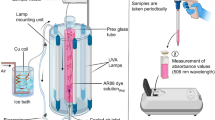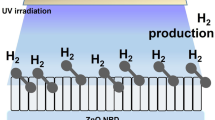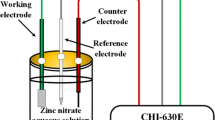Abstract
We report the deposition of indium doped zinc oxide thin films at various substrate temperatures 350 °C, 400 °C and 450 °C by spray pyrolysis technique. In: ZnO 1D nanorods are grown on these thin film seed layers by aqueous chemical growth process. The scanning electron microscopy and atomic force microscopy indicate that the surface morphology of the seed layers consists of nanopyramids of size in the range 123–380 nm. The growth of 1D nanorods is confirmed by FESEM. The structural, morphological, optical and electrical properties of the seed layers and nanorods are studied in detail. Enhanced visible luminescence has been observed for the 1D nanorods grown on the seed layers, eventhough the seed layers showed quenched emission characteristics. Photocatalytic activity of seed layers and nanorods grown at 450 °C are studied, and a degradation efficiency of 90% and 70% against methylene blue and methyl orange dyes respectively, are observed for the 1D nanorods.













Similar content being viewed by others
Data availability
The authors declare that the data supporting the findings of this study are available within the paper.
References
T.W. Hartley, Public perception and participation in water reuse. Desalination (2006). https://doi.org/10.1016/j.desal.2005.04.072
J.H. He, S. Te Ho, T.B. Wu, L.J. Chen, Z.L. Wang, Electrical and photoelectrical performances of nano-photodiode based on ZnO nanowires. Chem. Phys. Lett. (2007). https://doi.org/10.1016/j.cplett.2006.12.061
M. Law, L.E. Greene, J.C. Johnson, R. Saykally, P. Yang, Nanowire dye-sensitized solar cells. Nat. Mater. (2005). https://doi.org/10.1038/nmat1387
N.H. Alvi, M. Willander, O. Nur, The effect of the post-growth annealing on the electroluminescence properties of -ZnO nanorods/-GaN light emitting diodes. Superlattices Microstruct. (2010). https://doi.org/10.1016/j.spmi.2010.03.002
G. Torres Delgado, C.I. Zúñiga Romero, S.A. Mayén Hernández, R. Castanedo Pérez, O. Zelaya Angel, Optical and structural properties of the sol–gel-prepared ZnO thin films and their effect on the photocatalytic activity. Sol. Energy Mater. Sol. Cells (2009). https://doi.org/10.1016/j.solmat.2008.03.020
M. Ahmad, E. Ahmed, Y. Zhang, N.R. Khalid, J. Xu, M. Ullah, Z. Hong, Preparation of highly efficient Al-doped ZnO photocatalyst by combustion synthesis. Curr. Appl. Phys. (2013). https://doi.org/10.1016/j.cap.2012.11.008
F.D. Paraguay, J. Morales, W.L. Estrada, E. Andrade, M. Miki-Yoshida, Influence of Al, In, Cu, Fe and Sn dopants in the microstructure of zinc oxide thin films obtained by spray pyrolysis. Thin Solid Films 366, 16 (2000). https://doi.org/10.1016/S0040-6090(00)00752-5
T. Sakai, I. Nakano, M. Shimo, N. Takamori, A. Takahashi, Thermal direct mastering using deep UV laser. Jpn. J. Appl. Phys. (2006). https://doi.org/10.1143/JJAP.45.1407
J.B. Baxter, A.M. Walker, K. van Ommering, E.S. Aydil, Synthesis and characterization of ZnO nanowires and their integration into dye-sensitized solar cells. Nanotechnology (2006). https://doi.org/10.1088/0957-4484/17/11/S13
R. Amiruddin, M.C. Santhosh Kumar, High-speed photoresponse properties of ultraviolet (UV) photodiodes using vertically aligned Al:ZnO nanowires. Phys. Status Solidi 214, 1600658 (2017). https://doi.org/10.1002/pssa.201600658
L. Vayssieres, Growth of arrayed nanorods and nanowires of ZnO from aqueous solutions. Adv. Mater. (2003). https://doi.org/10.1002/adma.200390108
P.S. Patil, Versatility of chemical spray pyrolysis technique. Mater. Chem. Phys. (1999). https://doi.org/10.1016/S0254-0584(99)00049-8
F. Ynineb, N. Attaf, M.S. Aida, J. Bougdira, Y. Bouznit, H. Rinnert, Morphological and optoelectrical study of ZnO:In/p-Si heterojunction prepared by ultrasonic spray pyrolysis. Thin Solid Films 628, 36–42 (2017). https://doi.org/10.1016/j.tsf.2017.02.044
M. Eslamian, Spray-on thin film PV solar cells: advances potentials and challenges. Coatings 4, 60–84 (2014). https://doi.org/10.3390/coatings4010060
M. Ghosh, D. Karmakar, S. Basu, S.N. Jha, D. Bhattacharyya, S.C. Gadkari, S.K. Gupta, Effect of size and aspect ratio on structural parameters and evidence of shape transition in zinc oxide nanostructures. J. Phys. Chem. Solids 75, 543–549 (2014). https://doi.org/10.1016/j.jpcs.2013.11.007
J.L. Cervantes-López, R. Rangel, M. García-Méndez, H. Tiznado, O. Contreras, P. Quintana, P. Bartolo-Pérez, J.J. Alvarado-Gil, Indium-doped ZnO nanorods grown on Si (1 1 1) using a hybrid ALD-solvothermal method. Mater. Res. Express. (2017). https://doi.org/10.1088/2053-1591/aa7650
D. Raoufi, Synthesis and photoluminescence characterization of ZnO nanoparticles. J. Lumin. (2013). https://doi.org/10.1016/j.jlumin.2012.08.045
R. Amiruddin, M.C.S. Kumar, Epitaxial growth of vertically aligned highly conducting ZnO nanowires by modified aqueous chemical growth process. Ceram. Int. 40, 11283–11290 (2014). https://doi.org/10.1016/j.ceramint.2014.03.154
D. Mahesh, B.H. Kumar, M.C.S. Kumar, Enhanced luminescence property of 1D nanorods realised by aqueous chemical growth on indium doped zinc oxide thin films. Thin Solid Films 686, 137279 (2019). https://doi.org/10.1016/j.tsf.2019.04.054
K.G. Saw, N.M. Aznan, F.K. Yam, S.S. Ng, S.Y. Pung, New insights on the burstein moss shift and band gap narrowing in indium-doped zinc oxide thin film. PLoS ONE 10, e0141180 (2015). https://doi.org/10.1371/journal.pone.0141180
C.E. Benouis, M. Benhaliliba, A. Sanchez Juarez, M.S. Aida, F. Chami, F. Yakuphanoglu, The effect of indium doping on structural, electrical conductivity, photoconductivity and density of states properties of ZnO films. J. Alloys Compd. 490, 62–67 (2010). https://doi.org/10.1016/j.jallcom.2009.10.098
J. Tauc, R. Grigorovici, A. Vancu, Optical properties and electronic structure of amorphous germanium. Phys. Status Solidi (1966). https://doi.org/10.1002/pssb.19660150224
A. Sarkar, S. Ghosh, S. Chaudhuri, A.K. Pal, Studies on electron transport properties and the Burstein-Moss shift in indium-doped ZnO films. Thin Solid Films 204, 255–264 (1991). https://doi.org/10.1016/0040-6090(91)90067-8
S. Ilican, Y. Caglar, M. Caglar, F. Yakuphanoglu, Electrical conductivity, optical and structural properties of indium-doped ZnO nanofiber thin film deposited by spray pyrolysis method. Phys. E Low-Dimensional Syst. Nanostruct. 35, 131–138 (2006). https://doi.org/10.1016/j.physe.2006.07.009
M. Caglar, Y. Caglar, S. Ilican, Electrical and optical properties of undoped and In-doped ZnO thin films. Phys. Status Solidi (2007). https://doi.org/10.1002/pssc.200673744
I. Hamberg, C.G. Granqvist, Evaporated Sn-doped In 2 O 3 films: basic optical properties and applications to energy-efficient windows. J. Appl. Phys. (1986). https://doi.org/10.1063/1.337534
L. Liu, Z. Mei, A. Tang, A. Azarov, A. Kuznetsov, Q.K. Xue, X. Du, Oxygen vacancies: the origin of n -type conductivity in ZnO. Phys. Rev. B (2016). https://doi.org/10.1103/PhysRevB.93.235305
M.D. McCluskey, S.J. Jokela, Sources of n-type conductivity in ZnO. Phys. B Condens. Matter. (2007). https://doi.org/10.1016/j.physb.2007.08.186
G. Juárez-Diaz, J. Martínez, M.L. García-Cruz, R. Peña-Sierra, J.A. García, M. Pacio, Hall effect and conductivity in zinc oxide (ZnO) doped by thermal diffusion of indium and copper. Phys. Status Solidi (2010). https://doi.org/10.1002/pssc.200982851
S. Surthi, S. Kotru, R. Pandey, Low-voltage varistors based on La–Ca–Mn–O ceramics. Mater. Lett. (2002). https://doi.org/10.1016/S0167-577X(02)00890-X
T. Prasada Rao, M.C. Santhosh Kumar, A. Safarulla, V. Ganesan, S.R. Barman, C. Sanjeeviraja, Physical properties of ZnO thin films deposited at various substrate temperatures using spray pyrolysis. Phys. B Condens. Matter. 405, 2226–2231 (2010). https://doi.org/10.1016/j.physb.2010.02.016
P. Xu, S. Chaoshu, Electronic structure of ZnO and its defects. Sci China Math 44(9), 1174–1181 (2001)
M. Willander, O. Nur, J.R. Sadaf, M.I. Qadir, S. Zaman, A. Zainelabdin, N. Bano, I. Hussain, Luminescence from zinc oxide nanostructures and polymers and their hybrid devices. Materials. (2010). https://doi.org/10.3390/ma3042643
F. Leiter, H. Alves, D. Pfisterer, N.G. Romanov, D.M. Hofmann, B.K. Meyer, Oxygen vacancies in ZnO. Phys. B Condens. Matter. (2003). https://doi.org/10.1016/j.physb.2003.09.031
B. Lin, Z. Fu, Y. Jia, Green luminescent center in undoped zinc oxide films deposited on silicon substrates. Appl. Phys. Lett. (2001). https://doi.org/10.1063/1.1394173
A.B. Djurišić, Y.H. Leung, Optical properties of ZnO nanostructures. Small (2006). https://doi.org/10.1002/smll.200600134
K.U. Sim, S.W. Shin, A.V. Moholkar, J.H. Yun, J.H. Moon, J.H. Kim, Effects of dopant (Al, Ga, and In) on the characteristics of ZnO thin films prepared by RF magnetron sputtering system. Curr. Appl. Phys. (2010). https://doi.org/10.1016/j.cap.2010.02.028
D. Mahesh, M.C.S. Kumar, Synergetic effects of aluminium and indium dopants in the physical properties of ZnO thin films via spray pyrolysis. Superlattices Microstruct. 142, 106511 (2020). https://doi.org/10.1016/j.spmi.2020.106511
M.A. Reshchikov, V. Avrutin, N. Izyumskaya, R. Shimada, H. Morkoç, Anomalous shifts of blue and yellow luminescence bands in MBE-grown ZnO films. Phys. B Condens. Matter. (2007). https://doi.org/10.1016/j.physb.2007.08.191
B. Jin, S. Im, S. Lee, Violet and UV luminescence emitted from ZnO thin films grown on sapphire by pulsed laser deposition. Thin Solid Films (2000). https://doi.org/10.1016/S0040-6090(00)00746-X
K. Vanheusden, C.H. Seager, W.L. Warren, D.R. Tallant, J.A. Voigt, Correlation between photoluminescence and oxygen vacancies in ZnO phosphors. Appl. Phys. Lett. (1996). https://doi.org/10.1063/1.116699
H.J. Egelhaaf, D. Oelkrug, Luminescence and nonradiative deactivation of excited states involving oxygen defect centers in polycrystalline ZnO, in Selected topics in group IV and II–VI semiconductors. (Elsevier, 1996). https://doi.org/10.1016/B978-0-444-82411-0.50122-4
A.G. Acedo-Mendoza, A. Infantes-Molina, D. Vargas-Hernández, C.A. Chávez-Sánchez, E. Rodríguez-Castellón, J.C. Tánori-Córdova, Photodegradation of methylene blue and methyl orange with CuO supported on ZnO photocatalysts: the effect of copper loading and reaction temperature. Mater. Sci. Semicond. Process. (2020). https://doi.org/10.1016/j.mssp.2020.105257
W.Q. Peng, S.C. Qu, G.W. Cong, Z.G. Wang, Synthesis and temperature-dependent near-band-edge emission of chain-like Mg-doped ZnO nanoparticles. Appl. Phys. Lett. (2006). https://doi.org/10.1063/1.2182010
M.A. Rauf, S.S. Ashraf, Fundamental principles and application of heterogeneous photocatalytic degradation of dyes in solution. Chem. Eng. J. (2009). https://doi.org/10.1016/j.cej.2009.02.026
J. Liqiang, Q. Yichun, W. Baiqi, L. Shudan, J. Baojiang, Y. Libin, F. Wei, F. Honggang, S. Jiazhong, Review of photoluminescence performance of nano-sized semiconductor materials and its relationships with photocatalytic activity. Sol. Energy Mater. Sol. Cells (2006). https://doi.org/10.1016/j.solmat.2005.11.007
C.B. Ong, L.Y. Ng, A.W. Mohammad, A review of ZnO nanoparticles as solar photocatalysts: synthesis, mechanisms and applications. Renew. Sustain. Energy Rev. 81, 536–551 (2018). https://doi.org/10.1016/j.rser.2017.08.020
M.R. Hoffmann, S.T. Martin, W. Choi, D.W. Bahnemann, Environmental applications of semiconductor photocatalysis. Chem. Rev. (1995). https://doi.org/10.1021/cr00033a004
X. Hu, G. Li, J.C. Yu, Design, fabrication, and modification of nanostructured semiconductor materials for environmental and energy applications. Langmuir (2010). https://doi.org/10.1021/la902142b
S. Ben Ameur, H. BelHadjltaief, B. Duponchel, G. Leroy, M. Amlouk, H. Guermazi, S. Guermazi, Enhanced photocatalytic activity against crystal violet dye of Co and In doped ZnO thin films grown on PEI flexible substrate under UV and sunlight irradiations. Heliyon (2019). https://doi.org/10.1016/j.heliyon.2019.e01912
L.V. Trandafilović, D.J. Jovanović, X. Zhang, S. Ptasińska, M.D. Dramićanin, Enhanced photocatalytic degradation of methylene blue and methyl orange by ZnO: Eu nanoparticles. Appl. Catal. B Environ. 203, 740–752 (2017). https://doi.org/10.1016/j.apcatb.2016.10.063
Acknowledgements
The authors wish to acknowledge INUP-IISc since this research (or a portion thereof) was performed using facilities at CeNSE, funded by Ministry of Electronics and Information Technology (MeitY), Govt. of India, and located at IISc, Bengaluru. Author Devika M is thankful to the MoE, Govt. India, for the research fellowship.
Funding
No funding received for this research work.
Author information
Authors and Affiliations
Contributions
Conceptualization: MCSK, DM; Methodology: MCSK, DM; Formal analysis and investigation: DM, JP; Writing—original draft preparation: DM, JP; Supervision: MCSK.
Corresponding author
Ethics declarations
Competing interests
The authors declare that the authors have no competing interests as defined by Springer, or other interests that might be perceived to influence the results and/or discussion reported in this paper.
Additional information
Publisher's Note
Springer Nature remains neutral with regard to jurisdictional claims in published maps and institutional affiliations.
Rights and permissions
Springer Nature or its licensor (e.g. a society or other partner) holds exclusive rights to this article under a publishing agreement with the author(s) or other rightsholder(s); author self-archiving of the accepted manuscript version of this article is solely governed by the terms of such publishing agreement and applicable law.
About this article
Cite this article
Mahesh, D., Paul, J. & Kumar, M.C.S. Photocatalytic activity of indium doped zinc oxide seed layers and one dimensional nanorods under solar irradiation. J Mater Sci: Mater Electron 35, 86 (2024). https://doi.org/10.1007/s10854-023-11864-y
Received:
Accepted:
Published:
DOI: https://doi.org/10.1007/s10854-023-11864-y




